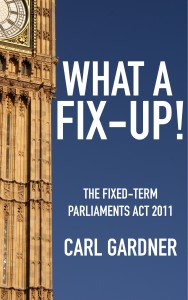Proportionality, at length: the Supreme Court’s “QASA” ruling
The Supreme Court has in today’s judgment in R (Lumsdon) v Legal Services Board ruled lawful the Quality Assurance Scheme for Advocates, as approved by the Legal Services Board. The scheme will require advocates to seek accreditation, which will require performance assessment by trial judges. The judgment’s unsurprisingly been welcomed by the Legal Services Board, but has disappointed those like the Criminal Bar Association who’ve objected to the scheme. The CBA said
The CBA remain of the view that the scheme is a bad one. At a time that the new Administration calls for the highest quality advocacy in the Crown Court the CBA feels that those best trained for such a service will have to go through this system (which will do nothing by way of positive measures to help advocates address weaknesses identified) in order to expose any lack in quality that was, on the evidence insofar as it was assessed, found not to exist to any significant degree at the Bar.
Apart from what it means for the practice of advocacy, the judgment’s interesting because of its lengthy and detailed explanation of the principle of proportionality in EU law. The applicants had argued that QASA was contrary to article 9 of the EU Services Directive (2006/123/EC) which permits national authorisation schemes controlling access to service activities only if they’re
justified by an overriding reason relating to the public interest
and if
the objective pursued cannot be attained by means of a less restrictive measure …
those two requirements together amounting to a classic definition of what lawyers call “proportionality”.
The Court of Appeal considered this – and mucked it up. It ruled that (para. 102)
It is not for the court to decide whether QASA is disproportionate. The court is not entitled simply to substitute its own views for those of the LSB: see R (Sinclair-Collis Ltd) v Secretary of State for Health [2011] EWCA Civ 437, [2012] QB 394, at paras 19-23 (per Laws LJ, dissenting), paras 115-155 (per Arden LJ) and paras 192-209 (per Lord Neuberger MR). We remind ourselves that we are reviewing the proportionality of the LSB’s decision. Even under a proportionality test, the decision-maker retains a margin of discretion, which will vary according to the identity of the decision-maker, and the subject-matter of the decision, as well as the reasons for and effects of the decision. A decision does not become disproportionate merely because some other measure could have been adopted. We accept the submission of Mr Giffin that the decision-maker’s view of whether some less intrusive option would be appropriate as an alternative is likewise not a question on which the court should substitute its own view, unless the decision-maker’s judgment about the relative advantages and disadvantages is manifestly wrong.
Some of this is right. But what’s wrong is the idea that a court was not entitled to decide for itself whether or not the scheme was proportionate. Actually, it had to do so (assuming the Directive applied). The legal question for the court was whether the scheme is proportionate – not whether it was lawful for the LSB to think it proportionate.
That major but simple error has provoked the Supreme Court to spend half of this judgment explaining at length (paras. 23-82) how proportionality works in EU law. We’re told the principle is not to be approached in the same way as human rights proportionality; and that the intensity of proportionality review varies, the Supreme Court giving examples in three categories of case.
This is all very interesting, and the Supreme Court cites plenty of case law to back up its approach. But I wonder how helpful it is, ultimately. I must admit to being suspicious of very detailed, fine-grained academic explanations of what are ultimately quite broad public law concepts like proportionality. The Supreme Court itself says (para. 23)
the only authoritative interpreter of that principle is the Court of Justice … It has also to be said that any attempt to identify general principles risks conveying the impression that the court’s approach is less nuanced and fact-sensitive than is actually the case
and (para. 34)
It is … important to avoid an excessively schematic approach …
I’m also sceptical of the sharp divide drawn in this judgment between EU proportionality, and human rights proportionality. Why should they be different, really? The more I look at Lord Reed’s and Lord Toulson’s explanation of the concept, the harder I find it to understand the distinction, especially since the Court of Appeal’s “subjectivist” error in this case was very like the error it made in a human rights context in the Begum case in 2006.
And are public law decision makers supposed to follow several different approaches to proportionality in different contexts? I think that’s too complex from the point of view of public servants and their advisers, who want to make good, defensible decisions.
The whole exercise has a slightly looking-glass feel when you realise that the Supreme Court ultimately agreed with the Court of Appeal that QASA is proportionate, and didn’t even decide whether the Services Directive applies. The QASA scheme may not, legally, have to be proportionate at all.
I’ve no doubt this judgment will now routinely be cited whenever EU proportionality is in question, but wonder how helpful it’ll actually be. Of course concepts can deceptively seem simple; but sometimes complexity also deceives. It might have been better just to reject the Court of Appeal’s “subjective” approach to proportionality – a plain mistake. Time will tell whether the Lumsdon classification makes proportionality clearer, or more obscure.

 All kinds of sensory experiences can affect thinking and impair judgement. Drinking, obviously; the inhalation of cannabis; and perhaps even the sight of a new Home Office bill.
All kinds of sensory experiences can affect thinking and impair judgement. Drinking, obviously; the inhalation of cannabis; and perhaps even the sight of a new Home Office bill.
 What a Fix-Up!
What a Fix-Up!